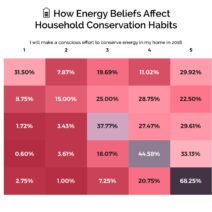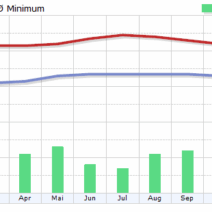The exploration of solar activity and its impact on Earth’s climate has captivated scientists and enthusiasts alike for decades. The sun, a colossal ball of nuclear fusion, has cycles of activity known as solar cycles, characterized by variations in sunspots, solar flares, and associated solar radiation. Typically, these cycles oscillate between periods of high solar output, known as solar maximum, and low solar output, referred to as solar minimum. A common observation in recent environmental discourse is the perplexing question: can low solar activity contribute to rising global temperatures? To understand this, we must delve deeply into the mechanics of solar dynamics, climate feedback systems, and the broader context of anthropogenic influences on climate change.
Solar activity is governed by the sun’s 11-year cycle, during which the number of sunspots oscillates. At solar maximum, sunspots become abundant, leading to greater emissions of solar radiation. Interestingly, during periods of solar minimum, numerous studies suggest a simultaneous decrease in solar output. Does this diminishment correlate with the global temperature fluctuations observed over the past century? The scientific community has examined this question thoroughly, yielding a nuanced perspective.
The crux of the matter lies in understanding how solar activity interacts with Earth’s climate system. It is well-documented that fluctuations in solar radiation can influence climate, especially over longer geological timescales. However, the direct correlation between low solar activity and contemporary rising temperatures is less straightforward. Although solar radiation does indeed impact atmospheric and oceanic temperature, the relative contribution of solar forcing is dwarfed by anthropogenic greenhouse gas emissions.
Historical climate data indicates that periods of low solar activity, such as the Maunder Minimum from the late 17th to early 18th centuries, were accompanied by cooler global temperatures. This phenomenon sparked the “Little Ice Age,” a time characterized by unusually cold weather in the Northern Hemisphere. Interestingly, the effect of diminished solar radiation appears to be temporary, often overshadowed by other climate influencers. In contrast, the modern era is witnessing unprecedented warming primarily attributed to the combustion of fossil fuels, deforestation, and various industrial activities that emit greenhouse gases into the atmosphere.
In the context of the current climate crisis, it is essential to note that while solar variability does contribute to climate fluctuations, the magnitude is relatively minimal compared to anthropogenic effects. The Intergovernmental Panel on Climate Change (IPCC) asserts that over the last century, human activities are responsible for more than 90% of the warming trend observed. As such, the impact of solar minimums—although relevant in discussing historical climate variations—pales in comparison to emissions of carbon dioxide and methane, which have skyrocketed since the industrial revolution.
The fascination with the implications of low solar activity lies in its potential to challenge or reinforce existing theories surrounding climate dynamics. While some theorists advocated for a direct link between reduced solar output and modern warming, extensive climate models and empirical evidence reject this notion. More specifically, recent research emphasizes the importance of feedback mechanisms within the Earth’s climate system, such as the albedo effect, ocean currents, and cloud formation, which all mediate incoming solar radiation and modulate global temperatures.
Moreover, the role of the oceans cannot be overstated. Oceans absorb significant amounts of solar energy and act as a thermal buffer, distributing heat throughout the atmosphere and preventing rapid temperature changes. The warming of surface waters, influenced predominantly by human-induced factors, leads to altered weather patterns and climate extremes, reinforcing the argument that solar activity alone is insufficient to account for contemporary trends.
In the broader discourse on climate phenomena, one must consider the compounding effects of natural variability and human agency. Solar activity should be viewed through the lens of a multifaceted climate framework, acknowledging that variances in solar energy are but one thread in the intricate tapestry of Earth’s climate system. Attention must remain focused on mitigating human-induced climate change, with an emphasis on drastically reducing greenhouse gas emissions, promoting energy efficiency, and advancing renewable energy technologies.
Moreover, as the scientific community continues to investigate the implications of solar variability, understanding the nuanced interactions between solar output and climate will become increasingly imperative. The remaining uncertainties highlight the complexity of climatology and offer fertile ground for further research. Investigation into the interplay between solar cycles and climate extremes warrants attention, particularly as global temperatures continue to climb at an alarming pace.
Ultimately, while low solar activity may hold theoretical relevance regarding historical climate shifts, the overarching narrative of rising global temperatures is inextricably linked to human activities. The challenge lies not in the quiet rhythms of the sun, but in humanity’s relentless exploitation of fossil fuels and ecosystems. As individuals and communities mobilize for climate action, the importance of understanding our role within this vast ecological web becomes evident. Addressing climate change requires not only awareness of natural phenomena but also a concerted effort to reduce our impact on the planet.
In conclusion, while low solar activity is a fascinating concept that warrants discussion within the context of climate science, it must be acknowledged that its role is overshadowed by the more pressing and immediate consequences of human actions on the environment. Education, advocacy, and practical solutions should remain at the forefront of climate discourse, ensuring that future generations inherit a habitable planet that reflects balance, sustainability, and reverence for the natural world.








